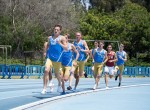The Bruins will be swapping their indoor spikes for outdoor spikes.
UCLA track and field will begin the second 10-week portion of its season outdoors, starting Friday at the Willie Williams Classic in Tuscon, Arizona.
Junior distance runner Robert Brandt – who had First-Team All-American finishes in both the 5000-meter and 3000-meter races at the NCAA Indoor Championships in Birmingham, Alabama – said he will take a lighter training load this week.
“I think a big thing now is just making sure I’m recovered after a long indoor season like that,” Brandt said. “A lot of kids, they’re kind of … training through indoor, but for me, it was a lot. A lot of racing, a lot of competing.”
Brandt said the narrow turns on indoor tracks such as the CrossPlex in Birmingham force runners into a strategic mindset that is not taken into consideration as much outdoors.
“Positioning is a lot more important (indoors),” Brandt said. “Whoever’s in the lead with two laps to go usually wins the race because it’s hard to pass guys when you’re tired going into the last 800 (meters) of those races. On the (CrossPlex) track it’s even harder – the turns are short … (Indoors) is definitely more strategic than outdoor racing.”
Brandt cracked UCLA’s outdoor top-10 list in both the 10,000-meter and 5,000-meter races last year with times of 29:02.14 and 13:41.23, respectively.
Sophomore thrower Alyssa Wilson was the only athlete in the country last year to qualify for the NCAA indoor and outdoor championships in all five throwing events – the indoor and outdoor shot put, weight throw, hammer throw and discus.
Wilson threw a season-best 22.23 meters on Feb. 8 in the indoor weight throw – a variation of the outdoor hammer throw unique to the United States.
The 4-kilogram NCAA women’s hammer is roughly 11 pounds lighter than the 20-pound weight and is more suitable for building momentum. Wilson said she’s happy to move on to outdoor events.
“(I) definitely (prefer) outdoors just because I have three events instead of two,” Wilson said. “I just like hammer and discus so much better than indoor shot and the weight (throw).”
The longer chain on the end of the hammer throw enabled Wilson to build enough momentum to toss 145 feet farther than her personal record in the weight throw.
“(For the weight throw), it’s better to be short and stubbier or on the bigger end,” Wilson said. “In the hammer (throw), you can range from short to giant (and) still figure out a way to throw it far. There’s more speed involved with the hammer (throw) where with the weight (throw) you just grip it and rip it.”
Wilson and freshman pole vaulter Sondre Guttormsen both said the temperate weather in Westwood eases the transition from indoors to outdoors for field athletes.
“There’s not a lot of difference, especially when we compete in California where it’s 70, 80 and 90 degrees all year,” Guttormsen said. “Of course you can have meets where the wind is swirling and changing and you get a headwind, but all in all it’s not that big of a change I think.”
Guttormsen’s hometown of Ski, Norway, receives around 1700 hours of sunshine per year whereas his new home at UCLA averages over 3200.
“In Norway, I prefer indoor better than outdoor better for sure because you never know what to expect the conditions (to be),” Guttormsen said.
